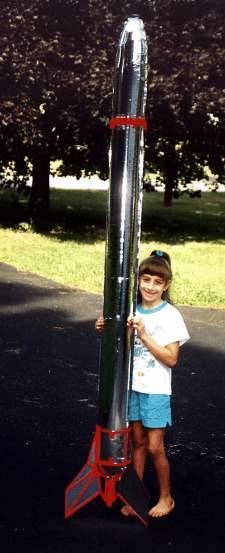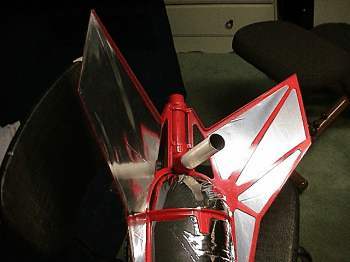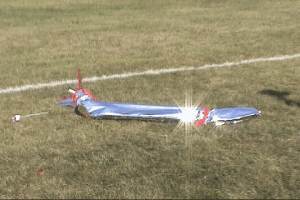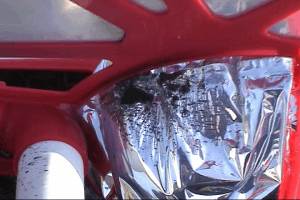| Construction Rating: | starstarstarstarstar_border |
| Flight Rating: | starstarstarstar_borderstar_border |
| Overall Rating: | starstarstarstar_borderstar_border |
| Length: | 88.00 inches |
| Manufacturer: | Estes  |
| Skill Level: | 2 |
| Style: | Sport |
 Brief:
Brief:
This is sure a strange rocket. It is 7.5' tall and uses a balloon for the body of the rocket! Fins and an engine mount are attached to the balloon which uses an 11' parachute for recovery. It flies only on a D12-3 engine. The whole thing weighs about 10 ozs.
It costs $19.97 at Walmart and that includes a launch pad and controller! The launch pad is just a plastic stake that you stick in the ground with a three piece rod that screws together (almost like the Aerotech Mantis rod but slightly smaller diameter) and a large 10.5" blast deflector. The controller is a standard Electron Beam.
I don't think the rod is very good and it bent a lot with the weight of the rocket and with a small breeze.
Construction:
The huge body is one large silver mylar type balloon, similar to the silvery party balloons that have become popular in recent years. The fins and motor mount are attached to a plastic sub-structure which the bottom of the balloon fits in. The plastic structure is glued together using airplane glue. The balloon is inserted into the structure and taped to it.
At the top of the rocket (actually 18" down) is the nose ring and it houses the weights which are required to properly set the CG. The ring is already pre-assembled and is held in place by tape. The plastic fin/motor mount assembly takes about an hour to put together and most of that time is waiting for the glue to dry.
The fins consist of a plastic frame and a sheet of mylar glued to it. The fins are already assembled.
 The motor mount is plastic and houses a D12-3. There is a retaining plastic cap that holds the motor in place. At the top of the motor mount is a right angle plastic pipe and a cardboard tube which sticks out about 3" from the side of the rocket. The wadding and parachute are stuff in there. The motor mount/right angle tube/cardboard tube assembly is already put together for you along with the chute. From the nose ring up on top is attached a fishing line which drapes down along the outside of the rocket and is attached to the chute.
The motor mount is plastic and houses a D12-3. There is a retaining plastic cap that holds the motor in place. At the top of the motor mount is a right angle plastic pipe and a cardboard tube which sticks out about 3" from the side of the rocket. The wadding and parachute are stuff in there. The motor mount/right angle tube/cardboard tube assembly is already put together for you along with the chute. From the nose ring up on top is attached a fishing line which drapes down along the outside of the rocket and is attached to the chute.
Estes gives you a straw to blow up the balloon. I used helium instead of air which has been stated on the Newsgroups to lighten up the rocket by 2 ozs. It blows up fast. But after 2 days it was getting limp as the air was leaking out of it.
The launch lugs are attached to the balloon using tape. The tape is supplied.
The instructions are typical Estes with pictures and words in English and French. The whole thing goes together really fast. There is one thing to look out for. You are instructed to insert these 3 plastic ring supports into the body ring using one drop of glue. Be careful here. If you use too much glue and clog up the rectangular opening, you won't be able to insert the fin assembly tabs later on.
Also, one other point which isn't clear is they say position the nose ring 18" from the tip of the rocket. But it isn't clear if you measure 18" to the top or bottom of the nose ring. The ring itself is about 1". I don't think it is critical.
The whole assembled rocket is kind of flimsy with a lot of flex in the large fins.
Finishing:
There are no decals supplied and no painting is required. You just assemble the rocket and fly!
Construction Rating: 4 out of 5
 Flight:
Flight:
The only recommended engine is a D12-3 which puts it up about 300'. There is a plastic cap which twists on the motor tube to hold the engine in. Estes recommends tapping the launch rod 19" up from the blast deflector. They don't say why but it is to position the rocket high enough off the pad. There was a light breeze and with the flimsy launch rod and the large surface area of the rocket, the rocket was very tilted on the pad. It was impossible for me to get the rocket to stand up straight! That 3 piece rod bents a lot! But because it was still safely aimed and because of the large field, I flew it anyway.
Recovery:
On the first flight it went straight up, slowly, arched over and finally the chute came out. Although the 11" chute seems small, it brought it down what looked like a good landing on grass. The fins, which hit first, really flexed a lot and I thought maybe were broken. When I got to the rocket, all fins were fine but the rocket was almost deflated. The top part of the rocket, when it hit the ground, got 3 small cuts in the balloon which quickly let the air out. Not having any scotch tape to repair, I had to call it quits. I believe many people will have problems with the balloon contacting the ground and getting small cuts. Perhaps a larger chute would help.
 On the second flight I removed the tape wrapped on the rod at 19" because I felt it was holding the rocket too far up on the rod, causing the rod to bend even more than what it could handle. And I still could not get the rocket aimed the way I wanted because of the bending rod and wind. Removing the tape was a mistake. Because on the second flight with the engine almost sitting on the deflector, the engine blast deflected off the deflector and hit AND MELTED the balloon. Even before the rocket clear the rod, the rocket was deflated enough to make it go out of control and crash right near the pad. I have a video of it on my site (click button above or below) on the rocket video page. Attached you see a picture of the bottom of the rocket with the melted holes.
On the second flight I removed the tape wrapped on the rod at 19" because I felt it was holding the rocket too far up on the rod, causing the rod to bend even more than what it could handle. And I still could not get the rocket aimed the way I wanted because of the bending rod and wind. Removing the tape was a mistake. Because on the second flight with the engine almost sitting on the deflector, the engine blast deflected off the deflector and hit AND MELTED the balloon. Even before the rocket clear the rod, the rocket was deflated enough to make it go out of control and crash right near the pad. I have a video of it on my site (click button above or below) on the rocket video page. Attached you see a picture of the bottom of the rocket with the melted holes.
Flight Rating: 3 out of 5
Summary:
This rocket gets a lot of attention where ever it goes. Its 7.5' tall and is bright silver. It comes with a launch pad and controller for $19.97 at Walmart. If you are like me and fly high power rockets and engines, flying a 7.5' balloon rocket from Estes is more or less just for fun and ha ha's. It is not a serious rocket but then again, it doesn't suppose to be.
Pro: Its big, its cheap, it flies good, it draws a crowd. It goes together very quickly. It goes only about 300' so you can fly it almost anywhere. It comes with a launch pad and controller.
Con: It rips easy and the launch rod is too flexible.
Overall Rating: 3 out of 5
Other Reviews
- Estes The Dude By Glenn Roth (August 8, 2008)
Brief: This is a large rocket that uses a mylar balloon as its airframe (like a blimp), is powered by a 24mm motor, and recovers by parachute. Construction: There is no body tube or payload, just an inflatable mylar balloon, and 4 fins. It uses a right angle motor mount for chute and motor with a monofilament line coming from the nose ring down to the parachute on the outside ...
- Estes The Dude By Victor R Gigante-Hueber
This is an interesting rocket from Estes. It is basically just a plastic fin canister with a large Mylar balloon on the front. It comes with a launch pad and a launch controller and can be ready to fly in a few hours. This rocket comes packaged with its launch pad and controller in a very brightly colored box. The rocket's parts are bagged and the launch set is taped to a piece of cardboard. ...
- Estes The Dude By Les Bradshaw
This rocket goes back to the time when the body of a rocket was so thin it could not support its own weight. The rockets relied on the pressurization of the fuel to keep them from collapsing. The Dude has a fin/motor mount cage and then a chrome covered nylon "balloon" that is inflated for the body and nose. There are no body tubes. A simple plastic cage consisting of 2 rings and 3 ...
 |
 |
Flights
 |
 |